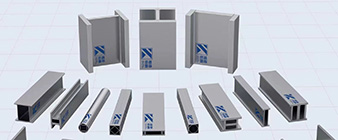The correct selection of S690 steel is critical to ensuring the reliability and durability of building structures. The following are key considerations and steps to guide the selection process:
Understand project needs
Loading conditions: Evaluate the types of loading (static, dynamic, seismic) the structure will encounter. Determine the maximum load and load combination.
Environmental factors: Consider environmental conditions such as temperature, humidity and exposure to corrosive elements.
Material Properties
Grade selection: Select the appropriate grade based on the mechanical properties of S690 steel (including yield strength, tensile strength and ductility). Common grades include S690QL, S690QL1 and S690QL2, each with specific features.
Thickness Considerations: Ensure the selected thickness meets design requirements while optimizing weight and cost.
Welding and Fabrication
Weldability: Verify the weldability of the selected S690 steel grade. Look for information on preheat and post-weld heat treatment requirements to avoid brittleness.
Fabrication techniques: Make sure your fabrication methods (cutting, welding, forming) are compatible with S690 steel to maintain its mechanical properties.
Corrosion Resistance
Protective coatings: Depending on the environment, consider applying protective coatings (e.g., galvanizing, paint) to enhance corrosion resistance.
Material Compatibility: Evaluate compatibility with other materials to prevent galvanic corrosion.
Design Considerations
Finite Element Analysis (FEA): Use FEA to model the structure and analyze stress distribution to ensure the design fully utilizes the characteristics of S690 steel.
Connection Design: Pay special attention to the design of joints and connections as they are critical to structural integrity.
Standards and Certifications
Comply with standards: Make sure the S690 steel you choose meets relevant standards (such as EN 10025-6) and quality assurance certifications.
Manufacturer reputation: Choose a reputable manufacturer that provides traceability and quality control documentation.
Life cycle considerations
Durability Assessment: Conduct a life cycle assessment to assess the long-term performance and maintenance needs of a structure.
Recyclability: Considering the recyclability of S690 steel at the end of its life cycle can help achieve sustainability goals.
Expert consultation
Hire a structural engineer: Work with structural engineers and materials experts to ensure selections meet design intent and performance standards.
Review case studies: Look at previous projects using S690 steel to understand best practices and potential challenges.
Quality Control Inspection and Testing: Rigorous inspection and testing protocols are implemented during the manufacturing and construction process to ensure materials meet specified standards and performance standards.
Carefully considering these factors when selecting S690 steel can enhance the reliability and durability of your building structure. Proper material selection, coupled with thoughtful design and manufacturing practices, will result in safer and more efficient engineering solutions.
-
 2024-9-20 How does high-strength S690 steel play a role in the construction field?
2024-9-20 How does high-strength S690 steel play a role in the construction field? -
 2024-1-02 Laser welded stainless steel structural Section
2024-1-02 Laser welded stainless steel structural Section -
 2024-9-16 What are the typical applications of 316 stainless steel and EN 1.4401 stainless steel?
2024-9-16 What are the typical applications of 316 stainless steel and EN 1.4401 stainless steel? -
 2024-9-20 2507 super duplex stainless steel in nuclear power of innovative applications
2024-9-20 2507 super duplex stainless steel in nuclear power of innovative applications -
 2024-9-29 Alloy 602 CA / 2.4633/N06025 Nickel-based alloy structural profiles for beams and columns
2024-9-29 Alloy 602 CA / 2.4633/N06025 Nickel-based alloy structural profiles for beams and columns -
 2024-9-16 S32205 VS UNS S31803 stainless steel profiles
2024-9-16 S32205 VS UNS S31803 stainless steel profiles -
 2024-9-20 1.4404 stainless steel in innovative applications in bridges
2024-9-20 1.4404 stainless steel in innovative applications in bridges



